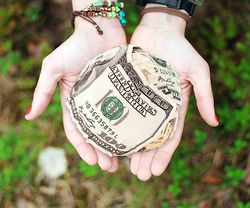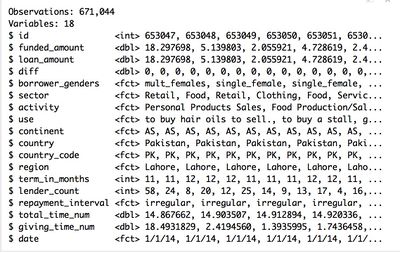Difference between revisions of "Group22 Report"
Jygao.2017 (talk | contribs) |
Jygao.2017 (talk | contribs) |
||
| Line 37: | Line 37: | ||
==<font size="5"><font color = "#367c45">Design Framework</font></font>== | ==<font size="5"><font color = "#367c45">Design Framework</font></font>== | ||
| + | ==<font size="3"><font color = "#367c45">Introduction</font></font>== | ||
| + | The Kiva loan dataset contains more than 600,000 records which include all information about 87 countries. Exploring such a big size dataset to garner any significant meaning can be a daunting task. | ||
| + | The basic purpose of the project is to explore why people loan from KIVA. Because what people loan can represent what they lack or what they want to do in their countries. The result of the project can be the guide to help KIVA or government to understand the social deeper. | ||
| + | To achieve the target above, we design an application by R-shiny. The app contains 6 taps. | ||
| + | *User guide: A brief introduction about the app. | ||
| + | *Heatmap: To cluster the countries by different geographic level. | ||
| + | *Global Map: To overview the distribution and loan purpose of all countries by special sector or loan amount. The pie chart shows you how many people loan for the selected sector in the country. The size of pie chare indicates how much people loan from KIVA. | ||
| + | *Tree Map: The first tree map can be used to overview how many people loan from KIVA in different countries. The second tree map can be used to compare the deeper purposes of people loan between two countries. | ||
| + | *Line Chart: Explore the change of loan amount and number of loans over three years. | ||
==<font size="3"><font color = "#367c45">Data Preparation</font></font>== | ==<font size="3"><font color = "#367c45">Data Preparation</font></font>== | ||
The original dataset includes 671,205 observations and 20 variables. We wrangled and cleaned data first to get a more essential dataset before we apply analysis which including deleting missing value, modifying data, extracting relative features and building new features. | The original dataset includes 671,205 observations and 20 variables. We wrangled and cleaned data first to get a more essential dataset before we apply analysis which including deleting missing value, modifying data, extracting relative features and building new features. | ||
| Line 53: | Line 62: | ||
[[Image:data.png|400px]] | [[Image:data.png|400px]] | ||
| − | ==<font size="3"><font color = "#367c45">Visualization | + | ==<font size="3"><font color = "#367c45">Visualization</font></font>== |
| + | *Heat Map Mode | ||
| + | A heat map is a graphical representation of data where the individual values contained in a matrix are represented as colors. In addition, the results of hierarchical clustering are presented in a dendrogram. | ||
| + | The reason why we want to do the clustering is help us focus on similar countries at first. | ||
| + | Heat map is plotted by Plotly which is quite friendly tool. Users are allowed to zoom in the heat map and dedrogram. | ||
| + | [[Image:kiva heat.png|800px]] | ||
| + | The heat map mode is used to find out the cluster. The first control is used to select the geographic level user want to explore. For example, according to continent level. Africa, Asia and Americas are cluster into the same group. Overview the heat map, people loan for food, retail and Agriculture in these three continents. It seems that primary industry is more important in Africa, Asia and Americas. | ||
| + | [[Image:kiva heat2.png|800px]] | ||
| + | The interface of country is same with geographic level, but the row of heat map become countries now. For example, Cambodia, Lao and Afghanistan can be regarded as a group. They have high demand for personal use. | ||
| + | In addition, according to different algorithm, hierarchical clustering can show different result. All controls are shown above the heat map. | ||
| + | *Tree Map Mode | ||
| + | Tree map is a method for displaying hierarchical data using nested figures, usually rectangles. | ||
| + | Compare with bar chart, tree map can contain more information clearly. | ||
| + | The tree map is plotted by googleVis which allow users combine different levels of tree map together. In addition, it’s an interactive tool. | ||
| + | [[Image:kivatreemap1.png|800px]] | ||
| + | The first tree map is used to overview the development of KIVA in different countries. It’s easy to find out most users are coming from Philippines. | ||
| + | [[Image:kivatreemap2.png|800px]] | ||
| + | [[Image:kivatreemap3.png|800px]] | ||
| + | The second tree map is more important. According to the cluster result of heat map mode, we can explore the details of different countries which are in the same group or different group. | ||
| + | *Time Series Mode | ||
| + | Lines charts were selected to display due to their suitability in representing time series data, especially when there was a need to display several time series in one plot. | ||
| + | The line chart is plotted by Plotly which is a friendly visualization tool. User can zoom in or select the information they care easily | ||
| + | [[Image:kivatime.png|800px]] | ||
| + | The y axis of line chart represents the loan amount. The unit of amount is American dollar. Users can control the countries, date range and attributes here. | ||
| + | *Map Mode | ||
| + | The KIVA dataset contains so many different countries. Map can be a good way to show all of them together. | ||
| + | There are two packages are used here. One is leaflet and the other one is leaflet minicharts. Because the original dataset doesn’t have completed information about latitude and longitude, we can’t use polygon directly. The leaflet can help us locate the countries easily. Although we have to use geocode to find out the latitude and longitude of all countries at first. | ||
| + | [[Image:kivamap123.png|800px]] | ||
| + | |||
==<font size="5"><font color = "#367c45">Demonstration</font></font>== | ==<font size="5"><font color = "#367c45">Demonstration</font></font>== | ||
==<font size="5"><font color = "#367c45">Discussion</font></font>== | ==<font size="5"><font color = "#367c45">Discussion</font></font>== | ||
Revision as of 17:57, 13 August 2018
|
|
|
|
|
Contents
Motivation of the Application
Poverty is one of the biggest long-term issues confronting the world today. Millions of people struggle to maintain the most basic standard of living for themselves and their families, and face a daunting uncertainty in many parts in their lives. Microfinance is one strategy and it attempts to address the issue of poverty by providing small-scale loans to the poor so that they can either start or expand a small business to improve their income, thus helping to bring them out of poverty.
Kiva is an international non-profit, founded in 2005 and based in San Francisco, with a mission to connect people through lending to alleviate poverty. By lending as little as $25 on Kiva, anyone can help a borrower start or grow a business, go to school, access clean energy or realize their potential. For some, it’s a matter of survival, for others it’s the fuel for a life-long ambition. And Kiva lenders have provided over $1 billion dollars in loans to over 2 million people in 87 countries.
The purpose of our application is to explore the reason why people loan from KIVA in different countries. The dataset contains 87 countries which are distributed around the world. It’s quite difficult to research the big size dataset directly. The application can help us understand the clear logic and find out some interesting insights relaxed.
Review and Critic on Past Works
Design Framework
Introduction
The Kiva loan dataset contains more than 600,000 records which include all information about 87 countries. Exploring such a big size dataset to garner any significant meaning can be a daunting task. The basic purpose of the project is to explore why people loan from KIVA. Because what people loan can represent what they lack or what they want to do in their countries. The result of the project can be the guide to help KIVA or government to understand the social deeper. To achieve the target above, we design an application by R-shiny. The app contains 6 taps.
- User guide: A brief introduction about the app.
- Heatmap: To cluster the countries by different geographic level.
- Global Map: To overview the distribution and loan purpose of all countries by special sector or loan amount. The pie chart shows you how many people loan for the selected sector in the country. The size of pie chare indicates how much people loan from KIVA.
- Tree Map: The first tree map can be used to overview how many people loan from KIVA in different countries. The second tree map can be used to compare the deeper purposes of people loan between two countries.
- Line Chart: Explore the change of loan amount and number of loans over three years.
Data Preparation
The original dataset includes 671,205 observations and 20 variables. We wrangled and cleaned data first to get a more essential dataset before we apply analysis which including deleting missing value, modifying data, extracting relative features and building new features.
- Delete Missing Value
- Translate all the money amount to USD currency. Original data use the local currency for each loan application which is not useful for our analysis.
- Create a new column named Continent.
- Calculate the time. 'total_time' means how much time passes from the moment the loan is posted to the moment it's disbursed; and 'giving_time' means how long does a loan take to get funded.
- Calculate the time difference between loan amount and funded amount.
- Converted “borrower_gender” variable. The original data is a gender list of the loan applicant. So we count the frequency of each list.
when female sum and length is 1, then conver to single_female When female sum and length females_count is the same and different to zero, then mult_females when female sum is zero and the count of individuals is 1, then “single_male "mult_males" when female sum is zero and the count of individuals is greater than 1 "mixed_genders" when the sum of females is different to the count of individual
The final dataset we used to do analytics includes 671,044 observations with 18 variables including basic loan information, geographic data, purpose explain and time distribution. And it looks like shown below:
Visualization
- Heat Map Mode
A heat map is a graphical representation of data where the individual values contained in a matrix are represented as colors. In addition, the results of hierarchical clustering are presented in a dendrogram.
The reason why we want to do the clustering is help us focus on similar countries at first.
Heat map is plotted by Plotly which is quite friendly tool. Users are allowed to zoom in the heat map and dedrogram.
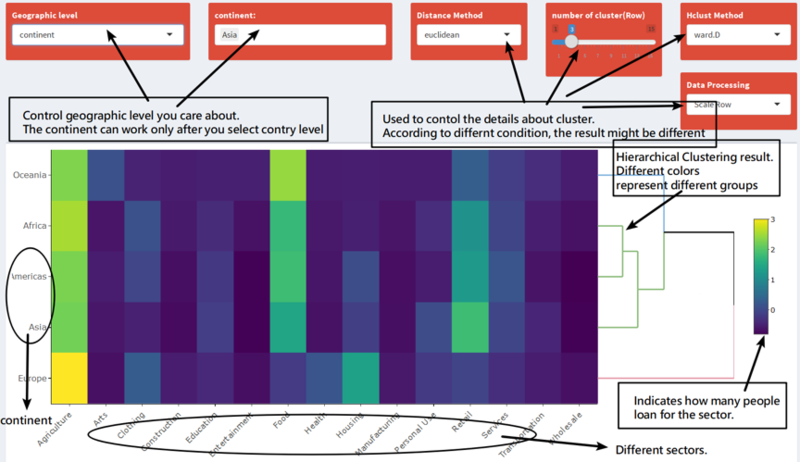 The heat map mode is used to find out the cluster. The first control is used to select the geographic level user want to explore. For example, according to continent level. Africa, Asia and Americas are cluster into the same group. Overview the heat map, people loan for food, retail and Agriculture in these three continents. It seems that primary industry is more important in Africa, Asia and Americas.
The heat map mode is used to find out the cluster. The first control is used to select the geographic level user want to explore. For example, according to continent level. Africa, Asia and Americas are cluster into the same group. Overview the heat map, people loan for food, retail and Agriculture in these three continents. It seems that primary industry is more important in Africa, Asia and Americas.
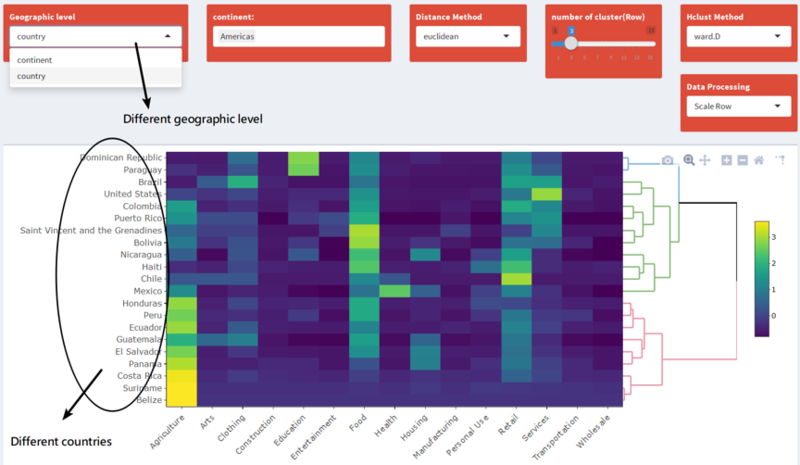 The interface of country is same with geographic level, but the row of heat map become countries now. For example, Cambodia, Lao and Afghanistan can be regarded as a group. They have high demand for personal use.
In addition, according to different algorithm, hierarchical clustering can show different result. All controls are shown above the heat map.
The interface of country is same with geographic level, but the row of heat map become countries now. For example, Cambodia, Lao and Afghanistan can be regarded as a group. They have high demand for personal use.
In addition, according to different algorithm, hierarchical clustering can show different result. All controls are shown above the heat map.
- Tree Map Mode
Tree map is a method for displaying hierarchical data using nested figures, usually rectangles.
Compare with bar chart, tree map can contain more information clearly.
The tree map is plotted by googleVis which allow users combine different levels of tree map together. In addition, it’s an interactive tool.
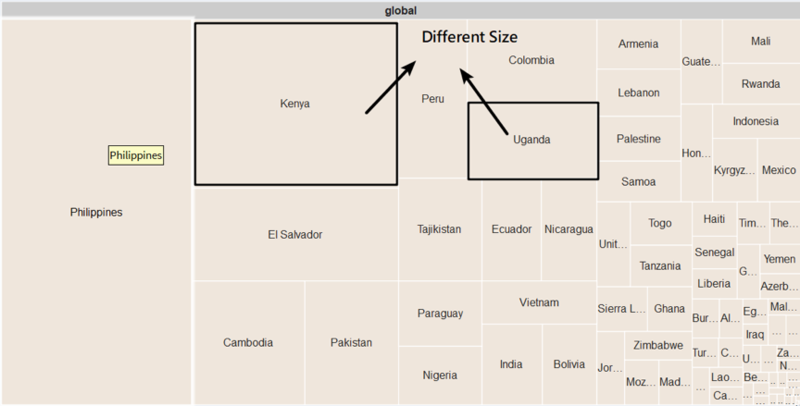 The first tree map is used to overview the development of KIVA in different countries. It’s easy to find out most users are coming from Philippines.
The first tree map is used to overview the development of KIVA in different countries. It’s easy to find out most users are coming from Philippines.
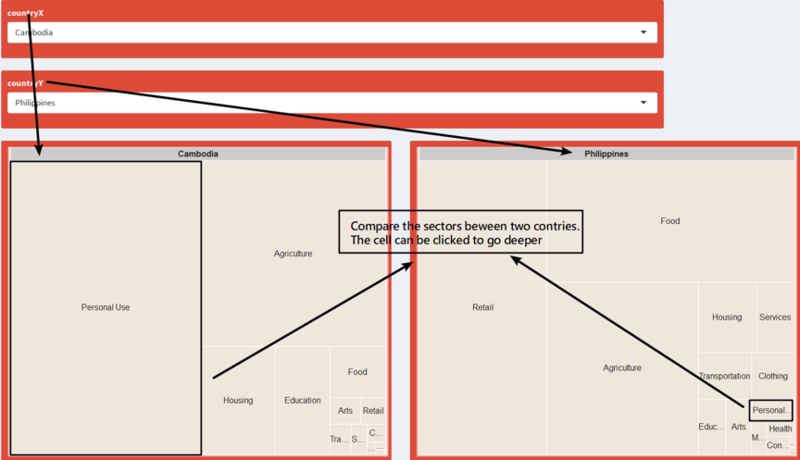
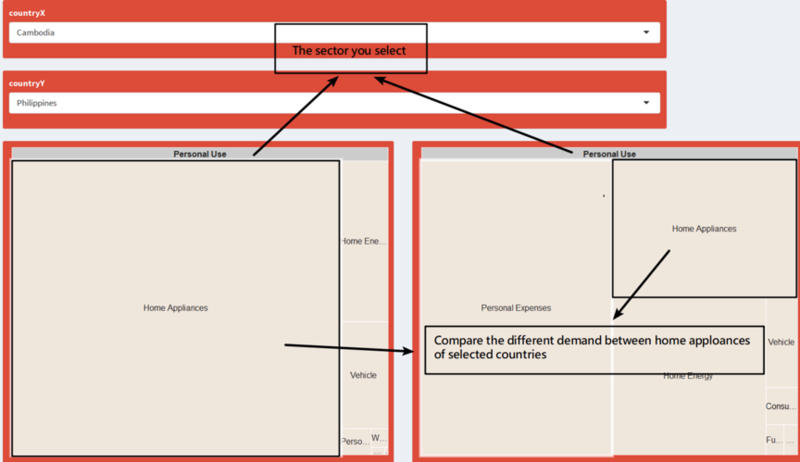 The second tree map is more important. According to the cluster result of heat map mode, we can explore the details of different countries which are in the same group or different group.
The second tree map is more important. According to the cluster result of heat map mode, we can explore the details of different countries which are in the same group or different group.
- Time Series Mode
Lines charts were selected to display due to their suitability in representing time series data, especially when there was a need to display several time series in one plot.
The line chart is plotted by Plotly which is a friendly visualization tool. User can zoom in or select the information they care easily
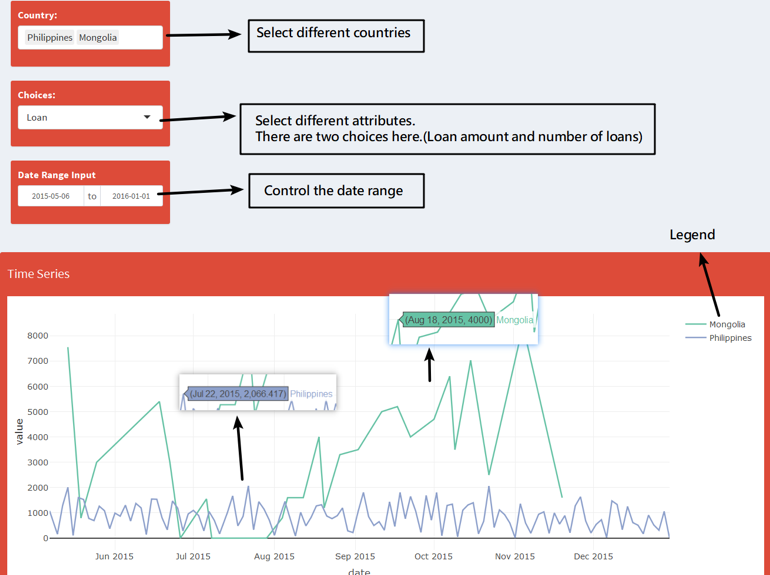 The y axis of line chart represents the loan amount. The unit of amount is American dollar. Users can control the countries, date range and attributes here.
The y axis of line chart represents the loan amount. The unit of amount is American dollar. Users can control the countries, date range and attributes here.
- Map Mode
The KIVA dataset contains so many different countries. Map can be a good way to show all of them together.
There are two packages are used here. One is leaflet and the other one is leaflet minicharts. Because the original dataset doesn’t have completed information about latitude and longitude, we can’t use polygon directly. The leaflet can help us locate the countries easily. Although we have to use geocode to find out the latitude and longitude of all countries at first.
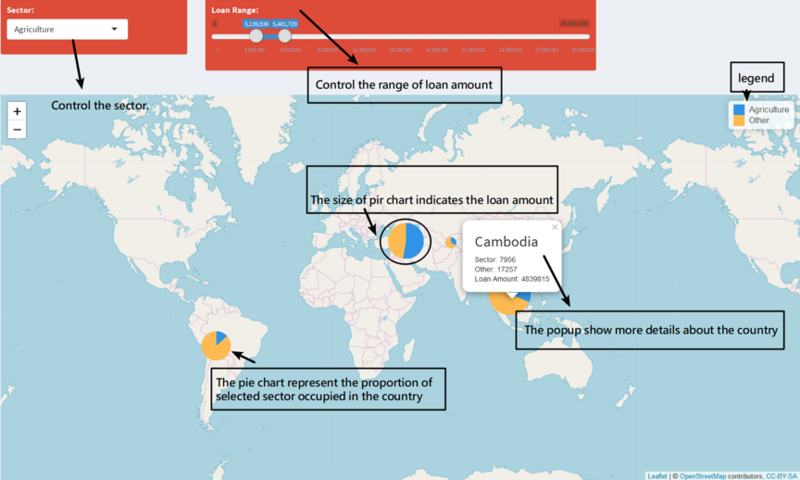
Demonstration
Discussion
Future Work
Installation Guide
User Guide
The Shiny application has 6 tabs:
- First tab shows the work flow and the design logic of the shiny application.
- Second tab 'HeatMap_Cluster' can be used to cluster different country.
- Third tab 'Map' is used to overview what sectors the country care more. In addition, the size of pie chart indicates the amount of loan. You can focus on special country based on the result of cluster.
- Fourth tab 'TreeMap_Global' can overview how many loan records are recorded.
- Fifth tab 'TreeMap_Compare' is used to compare the purpose of loan of two different countries. You can click the tree map and go deeper.
- Sixth tab 'Time_Series_Line' is used to explore the change of loan amount and number of records over three years.
